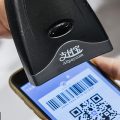Yum China Holdings Inc, operator of 5,300 KFC restaurants across China, introduced its first facial-recognition ordering kiosks in a concept store named KPRO in Hangzhou featuring low-calorie menus.
The tie-up with Alipay, the country’s largest mobile wallet, in commercializing such technologies underscores the ongoing digitalization push of the fast-food chain to leverage two trends: resonating with tech-savvy diners and jumping on the healthy-eating bandwagon.
With a color scheme of green and white to highlight the healthier fare, KPRO offers an assortment of made-to-order salads, paninis and roasted chicken, and is designed to cater to China’s burgeoning population of urban professionals, said Joey Wat, president and chief operating officer of Yum China.
“The restaurant, featuring fresh seasonal produce and integrating some of the latest technologies, serves as a bellwether for precise customer segmentation and allows us to better connect with the younger generation,” she said.
While uniforms and packaging still sport the KFC logo, the fat-laden fried chicken and fries that made it famous are nowhere to be seen. Food is complemented by freshly squeezed fruit juice, gourmet coffee, craft beer and premium low-fat ice-cream.
The restaurant itself has a relaxed cafe vibe. People are mesmerized by plants set up across the eatery, while aproned servers offer table service. An open kitchen puts ingredients and food preparation processes in full view of the diners.
Wat said the company has yet to set a target as to the number and the locations for new KPRO openings. But after a two-month trial run, 17 provincial markets including Beijing and Shanghai have expressed interest in introducing such outlets.
Going digital is a critical component to bolster the company’s lofty goal of adding 600 stores annually in a country where sophisticated customers turn to healthier food offerings in Asian flavors. Currently around 45 percent of KFC sales in China are conducted via mobile payment, up from less than 20 percent a year ago.
The brand, which staged 4 percent same-store sales growth in the quarter ended May 31, is exploding with great creativity of late. Apart from being smart and fast about rolling out digital payments and delivery, it also succeeded with offbeat advertisements featuring the 30th anniversary of the brand’s entry into China.
“For fast-food brands, embracing the trend of healthy and experiential dining is the key to growth in the near future,” said Summer Chen, research analyst at consultancy Mintel. “In the meantime, staying innovative can help to win over young consumers.”
Hangzhou restaurant unveils innovative tech for enhanced dining experience
KFC’s endeavor to let people pay their bills using facial recognition technology marks the world’s first such commercialized application.
That’s according to Chen Jidong, director of biometric identification technology at Ant Financial Services Group, which helped create the system.
“Yum China has a history of adopting innovative technologies to enhance in-store dining experience and we could think of no better place to pilot this advanced technology,” Chen said at the inaugural ceremony of KFC’s concept restaurant KPRO on Friday.
Upon a few taps on the screens to order, customers can look up into the camera, thereby sealing the deal. Alipay adopts a multi-step authentication process, including a facial scan and mobile phone number, to verify identities and facilitate payment.
Chen said the scanning system focuses on your face, so it doesn’t matter if you change your makeup or wear a wig. In the first instance, the machine would compare the detected face with the image logged by public security authorities.
The false recognition rate-that is, the likelihood that the biometric security system incorrectly rejects an access attempt by an authorized user-is near zero. But Chen noted the key to secure transactions is another gauge called the false-acceptance rate, or the chances that the system incorrectly accepts an unauthorized user.
“Currently the FAR stands at 0.002 percent. But we need to further lessen the percentage in order to apply the technology to a wide range of sophisticated scenarios, such as large-sum money transfers and cashier-less convenient stores, which require bank-level security,” he said.
The face-recognition system was first displayed in March 2015 by Jack Ma, founder of Ant’s parent Alibaba Group Holding Ltd. Since then, it is undergoing small-scale testing and is piloted for civic services such as tax declaration.
Rival Baidu Inc has used its own version of facial recognition as entry passes at tourist sites. But it has not yet unveiled payment-related solutions using the technology.


